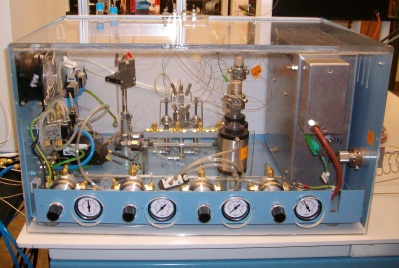Gas Bench II
δ13C and δ18O Carbonates
δ13C and δ18O ratios in carbonate minerals can be determined simultaneously by the analysis
of CO2 generated by the reaction of carbonate with 100% phosphoric acid. At SIF,
headspace vials are used to process carbonate samples. A known mass of sample is placed
in the headspace vial, dried overnight and then flushed with helium. A quantity of
100% phosphoric acid is then added. Depending on the carbonate material, the reaction
is allowed to proceed for 24-48 hours. Calcite and aragonite require 24 hours, while
dolomite and apatite require 48 hours. All of the carbon ends up in the headspace
of the vial in the form of CO2 gas, so that the δ13C of the CO2 gas is equivalent to that of the carbonate. Oxygen is partitioned
both into water and CO2 so that a calculation is required to get the isotopic composition
of the carbonate from the CO2 gas. The headspace CO2 is analyzed using the GasBench
attached to an isotope ratio mass spectrometer (GC-IRMS).
Typical sample size: 100-200 μg (calcite)
δ13C and δ18O of Atmospheric CO2
At SIF, the measurement of δ18O and δ13C ratios of CO2 in atmospheric air employs a GasBench headspace autosampler attached
to an IRMS. Once atmospheric air is introduced into a headspace vial, the vial is
simply placed in the GasBench for automated sampling. No further processing is required.
(GC-IRMS)
Typical sample size: not applicable
δ13C and δ18O of Breath CO2
In breath, the carbon isotope value (δ13C) provides information on the diet of the animal whereas the oxygen isotope value
of breath CO2 reflects the δ18O value of body water. For humans, this closely matches
drinking water. Animals that obtain a large portion of metabolic water from food
sources (vegetation, etc.) obviously would have isotope ratios of body water that
reflect this input. At SIF, the measurement of δ18O and δ13C isotope ratios of CO2 in breath employs a GasBench headspace autosampler attached
to an IRMS. Breath samples are collected in headspace vials and simply placed in
the GasBench for automated sampling. No further processing is required (GC-IRMS).
Typical sample size: not applicable
δ13C of Dissolved Inorganic Carbon (DIC)
When carbon is dissolved in water, it occurs in three different forms: CO2, HCO3,
and CO3. These species are commonly referred to as dissolved inorganic carbon (DIC).
To determine the δ13C ratio of this carbon, it is necessary to quantitatively remove all the carbon
from the water sample. At SIF, the procedure used is to add an aliquot of 100% phosphoric
acid (H3PO4) to a headspace vial, which is then flushed with helium. The sample water
is injected into the vial. The acid protonates the DIC, releasing CO2 into the vial
headspace. The CO2 is then analyzed using the GasBench attached to an isotope ratio
mass spectrometer (GC-IRMS).
Typical sample size: 1-5 ml
18O of Water (CO2/H2O Equilibration)
The δ18O value of water can be easily determined by equilibrating the water with CO2. When CO2 dissolves in water, oxygen atoms are exchanged through a mechanism that involves the hydration of dissolved CO2 to form carbonic acid (H2CO3). By using an excess of water compared to the amount of CO2 present, the above hydration process will allow the CO2 to take on the value of the δ18O ratio in the water (after correcting for a known liquid-gas phase equilibrium fractionation). At SIF, the headspace vial is flushed helium gas followed by an injection of the water sample. The vials are then allowed to equilibrate for 24 hours. The Finnigan GasBench is then used to automatically sample the CO2 in the headspace of the vials before the sample is analyzed in the IRMS. (GC-IRMS) Typical sample size: 1-5 ml

